Norfolk schoolgirl April Fabb's 'agonising' disappearance
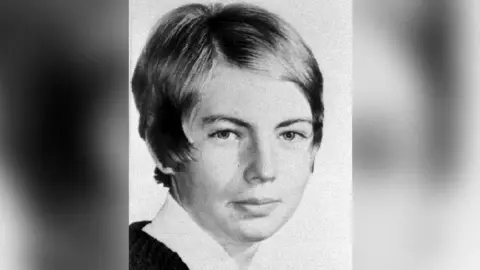 Fabb family
Fabb familyIt's a horror every parent dreads: the disappearance of a child. But the passage of half a century since 13-year-old April Fabb vanished has done nothing to ease the pain felt by the community where she lived - nor the terrible fascination with finding the answer which, 50 years on, may still lie in their midst.
The sun was shining as April climbed on to her bicycle on 8 April 1969.
It was the Easter holidays and the 13-year-old planned to ride the two miles from her sleepy Norfolk hamlet to her sister's house, excited at delivering a birthday present of 10 cigarettes to her brother-in-law.
But April never arrived.
"Quite frankly," says PR guru Michael Cole, who was a BBC reporter at the time, "she had vanished off the face of the earth".
Police launched the biggest search operation the county had ever seen. Since her disappearance, officers have visited 400 houses, conducted hundreds of interviews, taken nearly 2,000 statements, and spent countless hours on the case, yet have never come close to an answer.
Retired detective Maurice Morson inherited the case in 1983 and has since written a book on the subject.
"She's Norfolk's Mary Celeste, our Lord Lucan," he says. "It's the mystery of the unknown."
 Norfolk Constabulary
Norfolk ConstabularyFor people of a certain age, the face of April Fabb is a familiar one.
The youngest of the three daughters of Ernest and Olive Fabb, she lived at 3 Council House in Metton near Cromer. Her sisters Pamela and Diane had already moved out.
A shy girl, she was an animal-lover who doted on the family's terrier, Trudy. Her interests were typical of a teenager of the time: she enjoyed stamp-collecting, needlework and watching Top of the Pops.
On her bedroom walls were posters of her favourite band, Amen Corner. They were to remain there for years after her disappearance, untouched by her parents in the hope that she would one day come back.
The first sign that anything was wrong came as night fell on Tuesday, 8 April and the teenager had still not returned. At 22:00 BST, after learning April had not been seen all day, her parents raised the alarm.
By then, unknown to them, her bike had been found in a field near Metton by a passing motorist and taken to a police station at Cromer. That discovery added to officers' early fears that April had not simply run away.
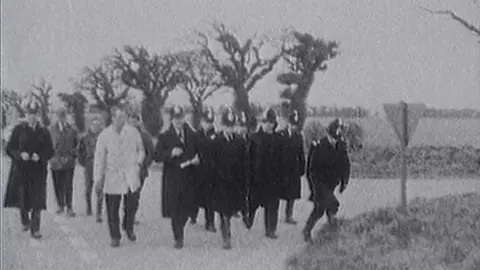
In the early hours of 9 April, Norfolk's most senior detective Det Ch Supt Reginald Lester was called in. He immediately grasped the implications and suspected that April must have been abducted. It was a case that would haunt him until his death 48 years later.
The search he led was the biggest in the history of the Norfolk force. On the first day, it involved 40 officers and every police dog in the county, nearly doubling Metton's population.
Members of the Aylsham Round Table assisted, an RAF helicopter hovered overhead, distant relatives were contacted. Descriptions of April, 5ft 4ins, with light brown hair and blue eyes, were circulated.
Her family clung to the hope her absence had an innocent explanation. "She's the sort of girl that if she saw some primroses she would most likely go and pick them," her father said.
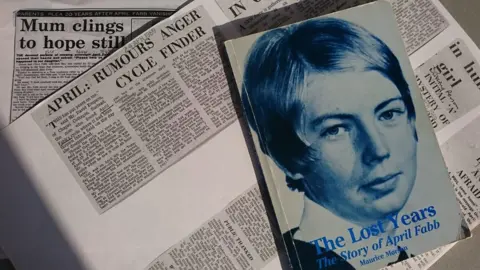
By Thursday, the second full day, more locals were helping, desperate to find a girl most of them knew.
It was "a day of clues", said Friday's Eastern Daily Press. A bloody handkerchief embroidered with "A" was found. Reports came in of a speeding van spotted in Metton on Tuesday afternoon. Passengers remembered seeing a teenage girl boarding a train to Norwich.
The urgency increased: frogmen searched lakes, posters of April were put up at railway stations, and cafes and hotels were checked for sightings.
By Friday, three days after she had last been seen, her parents appealed to her directly through the press to return. They refused to lock the door overnight, leaving a light on in the porch.
As information mounted and witnesses came forward, police pieced together a timeline.
The missing minutes
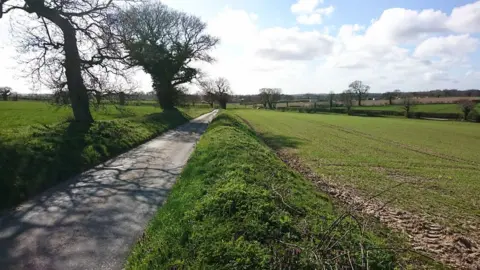
As April left Metton to ride to her sister Pamela's house, she saw two friends playing with a donkey in a farmer's field.
She stopped to pet it, then resumed her journey.
The last sighting of the 13-year-old was by the driver of a Land Rover passing in the opposite direction as she left the hamlet, at 14:06.
Nine minutes later, April's bike was seen in a field by three Ordnance Survey workers passing from a distance. It had been thrown over a six-foot bank on the country lane where April had been riding.
What happened in those few minutes holds the key to the fate of the teenager.
As time passed, the trail grew cold.
The bloody handkerchief had been used by a woman on her son's grazed knee. Drivers presented their alibis, and the runaway theory was discounted.
"Theories that April was abducted are being expounded in shops, pubs and over garden fences," reported the Eastern Daily Press, adding that some still suspected she had run off and was afraid to return.
Prayers were said for April's family on Sunday morning, and local businesses chipped in for a reward fund.
But good intentions could not mask a lack of progress. A month on from her disappearance, the headline in the local paper read: "Still no news of missing schoolgirl".
 Michaelcole.tv
Michaelcole.tvIt was clear from an early point that April had been abducted, says Michael Cole.
"It was a horrific crime because in the 50 years since, there's been not one shred of credible evidence as to her fate or her remains," he said.
"It remains a mystery. And that is agonising for her family and the people who knew her."
With no breakthroughs and few clues, national attention soon waned.
Mr Cole went on to enjoy a career in which he travelled the world, but the story stayed with him.
"A cataclysm was visited upon this community that didn't know what to do about it," he said.
"But it's the little details that are so heart-breaking. Her pathetic possessions: in her saddlebag she had 10 cigarettes for her brother-in-law, fivepence ha'penny and a handkerchief."
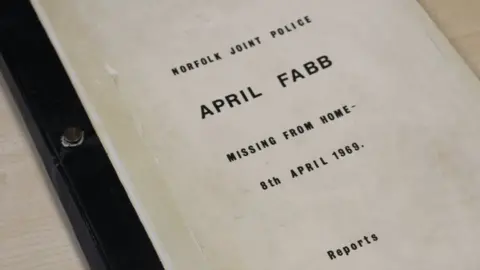 Norfolk Constabulary
Norfolk ConstabularyThose possessions remain in an evidence store at Norfolk Constabulary; April's bike was disposed of at her mother's request years ago.
They are the responsibility of retired Det Ch Insp Andy Guy, the cold case manager who has learned April's file "pretty much inside out" since 2005.
He believes April was either abducted by a predator passing through Metton, or by a local person who, he admits, "we have never really had enough in our sights".
He still hopes the information that could solve the case might lie in the local community. Is there someone who acts strangely around the anniversary, or in the area where April was snatched?
"I think there's something," he says. "In 1969, I don't think we totally exhausted those inquiries.
"When you look at things with a modern mindset, there are still things we didn't get to the bottom of."
 Norfolk Constabulary
Norfolk ConstabularyPolice today have the benefit of automatic number plate recognition, CCTV and mobile phone records.
"It was very different [then] because all they had was the witnesses," he says. "There were very few lines of inquiry to go down."
The belief that someone might yet come forward with crucial evidence has been fuelled by fresh leads in the past decade.
In 2010, police excavated a well near Metton after hearing the landowner had seen black polythene sheeting at the bottom at the time of April's disappearance.
The following year, reports came in that a man had been seen digging a grave nearby on the Easter weekend in 1969.
The leads underline the public interest in the case: even though it is one of the oldest of Norfolk's 59 cold cases, it still generates information.
Theories are handed down among families, and police appeals prompt fresh discussions online.
Det Ch Insp Guy believes the "domestic hook" of April's case makes it stick in the mind. "She was a good girl from a good family, in an idyllic rural setting. Everyone can relate," he says.
Maurice Morson, now retired more than 30 years, still gets tip-offs. "Whenever it comes to an anniversary, I get notes through the door with information," he says.
"People draw me maps; they tell me where she is. They've had a dream, they know someone who knows someone, or have a theory they think we've not explored."
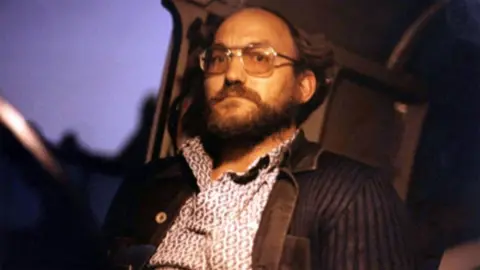 PSNI
PSNIOne man whose name has been put forward as a possible suspect is Robert Black, the notorious Scottish serial killer who died in prison in 2016 while serving life for the murder of four girls between 1981 and 1986.
Although a striking feature of April's disappearance fits with Black's modus operandi - he would snatch his victims from the roadside - police have never found any evidence to link him to Norfolk in 1969.
Many locals still believe the construction works for the Bacton gas terminal could be where April's body was left, but police say they have searched the pipelines thoroughly, to no avail.

By the door of the church April used to attend stands a memorial to the teenager.
The headstone, funded by the proceeds of Maurice Morson's book, is surrounded by daffodils by the time of the anniversary every spring.
April's father died in 1998 and her mother in 2013, without being able to lay her to rest.
Her sisters, who still live in the area, are informed of any new developments by police. Mr Morson, too, remains in contact with the family.
"April would have been 64 this month," he says. "She would probably have been a grandmother.
"To find out what happened now would probably cause fresh anguish for the family, to think that the mother and father never knew.
"But the objective is to find the truth. Will we ever find it?
"I don't know."
